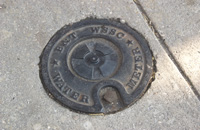|
 |

|
Tools and Technical Assistance
 EPA provides tools and technical assistance to the water sector and other organizations to help ensure the continued security of our nation's drinking water and wastewater systems. Available resources assist water utilities in performing vulnerability assessments and developing effective emergency response plans. Trained environmental professionals, scientists, and engineers provide information on technological advances in water security and supply technical assistance to the water sector and other agencies. Health care providers can access resources that can help them to recognize and manage waterborne disease. The tools listed below can help water utilities and public health and safety personnel to develop and apply appropriate antiterrorism measures and to respond effectively in the event of an incident.
EPA provides tools and technical assistance to the water sector and other organizations to help ensure the continued security of our nation's drinking water and wastewater systems. Available resources assist water utilities in performing vulnerability assessments and developing effective emergency response plans. Trained environmental professionals, scientists, and engineers provide information on technological advances in water security and supply technical assistance to the water sector and other agencies. Health care providers can access resources that can help them to recognize and manage waterborne disease. The tools listed below can help water utilities and public health and safety personnel to develop and apply appropriate antiterrorism measures and to respond effectively in the event of an incident.
- Security Product Guides - EPA has developed a series of individual Security Product Guides to assist water treatment plant operators and utility managers in reducing risks from, and providing protection against, possible natural disasters and intentional terrorist attacks. The guides provide information on a variety of products available to enhance physical security. A recent update provides eight new and three updated individual Security Product Guides.
- Security-Related Sample Questions for State/Tribal Drinking Water and Wastewater Operator Certification Exams Now Available Through the Association of Boards of Certification - The Association of Boards of Certification (ABC) has developed security-related sample questions for use by state and tribal drinking water and wastewater operator certification exam programs in the United States. These questions address security topics including emergency planning, vulnerability assessments, mitigation measures, emergency response, and crisis communications. In order to receive these questions, certification programs must sign an agreement indicating that the questions will be maintained in a secure location and will be used only for certification/licensing exams. The questions are available free of charge and will be shipped in electronic format upon ABC's receipt of the signed agreement. Please contact Suzanne De la Cruz of ABC via email at sdelacru@abccert.org or via telephone at 515-232-3623 to obtain the agreement, or if you have comments or concerns.
- Technical Assistance for Eligible Water Community Systems Serving 50,000 to 99,999 People
 - The International City/County Management Association and the Water Environment Federation, with funding from EPA, provide technical assistance in completing vulnerability assessments and emergency response plans. - The International City/County Management Association and the Water Environment Federation, with funding from EPA, provide technical assistance in completing vulnerability assessments and emergency response plans.
- Water Information Sharing and Analysis Center (WaterISAC)
 - WaterISAC is a service developed to provide America's drinking water and wastewater systems with a source of information about water system security and with a secure Web-based environment for early warning of potential threats. Relying on information gathered from federal intelligence, law enforcement, public health, and environmental agencies, and from utility security incident reports, WaterISAC analysts produce and disseminate physical and cyber security information to the water sector. - WaterISAC is a service developed to provide America's drinking water and wastewater systems with a source of information about water system security and with a secure Web-based environment for early warning of potential threats. Relying on information gathered from federal intelligence, law enforcement, public health, and environmental agencies, and from utility security incident reports, WaterISAC analysts produce and disseminate physical and cyber security information to the water sector.WaterISAC was established by the Association of Metropolitan Water Agencies, with support from EPA and guidance from other national water organizations. Its information and tools provide an important link between the water sector and such agencies. In addition, WaterISAC provides a variety of resources to help utilities complete and continually improve the vulnerability assessments and emergency response plans required by law for many water systems.
- Trained Security Assistance Providers for Wastewater Systems - No-cost, on-site vulnerability assessment and emergency response plan assistance is available to small and medium wastewater utilities through the Wastewater Operator Training Program. These environmental assistance providers received specific training on the wastewater Vulnerability Self-Assessment Tool (VSAT) software developed by the Association of Metropolitan Sewerage Agencies
 . Contact your appropriate state environmental assistance provider for aid. . Contact your appropriate state environmental assistance provider for aid.
- Recognizing Waterborne Disease and the Health Effects of Water Pollution: Physician On-Line Reference Guide
 - This guide helps healthcare providers recognize and manage waterborne disease and the health effects of water pollution resulting from natural or intentional contamination of water. The Web site offers free access and 24/7 availability, clinically relevant information, and a repository of physician antiterrorism preparedness resources. - This guide helps healthcare providers recognize and manage waterborne disease and the health effects of water pollution resulting from natural or intentional contamination of water. The Web site offers free access and 24/7 availability, clinically relevant information, and a repository of physician antiterrorism preparedness resources.
- Vulnerability Assessments - Tools are available to help educate the water sector in effective vulnerability assessment methodologies.
- Emergency/Incident Planning - Effective remediation and response tools help protect the security of drinking water and wastewater systems in the event that a man-made or technological emergency occurs.
|

|

